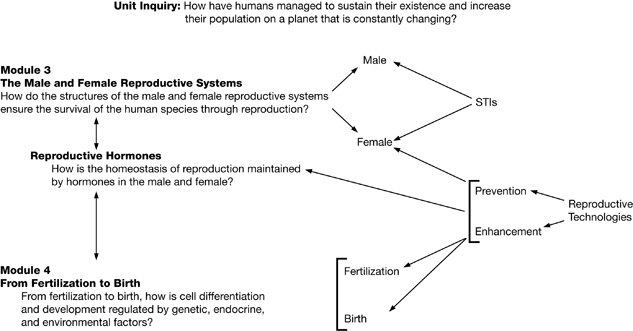Concept Organizer
1. Concept Organizer
Unit B Concept Organizer
The following concept organizer shows the relationships among the reproductive structures, hormones, and development. A mammalian reproductive system that functions properly is needed for a healthy body and to produce a healthy family. This leads to the continuation of the species. In the concept organizer, the unit inquiry indicates how reproductive systems, hormones, and development are required to produce healthy offspring. The importance of how reproductive technologies affect all areas is shown, as well as the transmission of sexually transmitted infections. You may find it beneficial to refer to this concept organizer as you work through the unit. You may also want to use it as a study guide.

Module 3—The Male and Female Reproductive Systems
In Lessons 1 to 5 of Module 3 you will examine both the male and female human reproductive systems. You will examine the structures, their functions, and their role in producing the sex cells, or gametes. You will learn the differences between primary and secondary sex characteristics and be able to compare and contrast the sperm and egg. Finally, you will study how sexually transmitted infections may affect reproductive systems and a developing fetus.
You will be asked to apply your knowledge to answer the following question:
-
What are the structures of the male and female reproductive systems, and how do these structures function to ensure the survival of the human species through reproduction?
In Lessons 6 to 9 of Module 3 you will learn how hormones regulate both the male and female reproductive systems. You will study how the hormone feedback system initiates puberty, maintains a constant level of function through the reproductive years, and causes change in the aging process in males. You will examine the detailed hormonal control of the monthly menstrual cycle, the consequences to the cycle depending on whether or not fertilization has occurred, and the hormonal action that results in menopause in females.
At the end of this module, your knowledge should allow you to answer the following question:
-
How is the homeostasis of reproduction maintained by hormones in the male and female?
Module 4—From Fertilization to Birth
In this module you will learn about the process of human development. You will review the key development periods of fertilization, cleavage, implantation, cell differentiation, and placental and fetal development to the outcome of birth. You will examine substances and conditions that can affect normal embryonic and fetal development. Lastly, you will focus on reproductive technologies—those that prevent and those that enhance reproduction potential. You will also examine the ethical, moral, legal, and personal issues that surround these technologies.
Through completion of this module, you will be able to answer the following question:
-
What is normal embryonic and fetal development, and how can genetic, hormonal, and environmental factors affect this development?